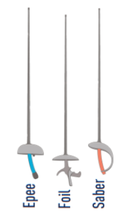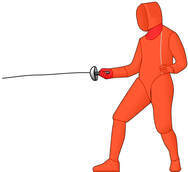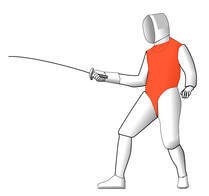What To Expect (for your first class)
- Clothing you can exercise comfortably in
- Loose fitting athletic pants (sweatpants are ideal)
- Athletic shoes (gym, running, trail, basketball)
What will I be doing?
- 1:1 or small group overview of the fundamentals of fencing & terminology
- What each piece of equipment is
- How fencing bouts are scored and refereed
- What in the world en garde ! prêts? allez! means
- En Garde stance
- Starter Footwork
- Starter Attacks
- Starter Parrys
Will I get to participate in a bout?
- Yes!!! Every class offers the opportunity to fight in a refereed bout
- This is one of the best ways to learn!
- It provides the opportunity to really find out what fencing is all about. Experience how exciting, fun, and safe it is
Cost
- Your first private lesson is free (no class fees). However, you must register with USA Fencing after your first class which costs $29 / year for their Access Membership. This is a national USA Fencing requirement for all sanctioned clubs and includes secondary medical/accident insurance. You can signup anytime before your second class starts at www.usafencing.org (talk to your Coach for more information or assistance)
Is fencing safe? Yes!!
What Is Olympic Fencing
Summer Olympic programme since 1896
Summer Paralympic programme since 1960
Athletics, swimming, fencing, and artistic gymnastics are the only summer sports that have never been absent from the Olympic programme
- Fencing is a sport of skill, stamina, tactics, and respect.
- It's considered one of the safest sports around — safer than basketball, football, soccer, baseball and cheerleading
- It comprises three weapons, each with a distinct style and target area.
- It's fun for all ages and provides an active and social setting
- All sizes, body types, backgrounds, abilities and skill levels are welcome
- Fencing develops important physical skills such as speed, strategy, coordination and agility
- Fencing builds character and develops life lessons such as discipline, respect, maturity and sportsmanship
- Fencing provides both individual and team competition opportunities
- It's a lifelong sport, with competitors ranging from age seven to 80-plus
- Fencing continues in college, it is a proven way for many young people to get a leg up in the application process
- Fencing is a sport with a long history of inclusion and belonging
- Above all else, fencing is FUN!
Fencing includes both individual and team competitions. Points are received by making a touch in the opponent’s target area. Individually, the goal is to reach 15 points (in direct elimination) or five points (in pools) before your opponent, or have a higher score before time expires.
The Action
Fencers seek to maintain a safe distance from each other while creating opportunities to attack. At times, a fencer will make a false attack to gauge the types of reactions of their opponent. When a hit is made, the referee stops the bout, describes the action, and decides whether to award a touch (a point). The referee always clearly raises their hand on the side of the fencer for whom they have awarded a point. Watching these signals can make it easier for newcomers to follow the momentum of a fencing bout without understanding every rule.
The Objective
The goal of a fencing bout (that's what an individual “game” is called) is to score a set number of points before your opponent can do the same or time expires. Each time a fencer scores a touch, they receive a point. Points are earned by making a touch in the opponent’s target area. Direct elimination matches in epee and foil consist of three 3‐minute periods with a 1‐minute break between each. In saber, the first period lasts for eight touches, and the second period ends when the first fencer scores 15 points.
The Safety
Is fencing dangerous? Does fencing hurt? Well, as strange as it sounds – since the sport includes “hitting” each other with metal blades and so on – fencing is one of the safest sports in the world. Modern fencing is about scoring points with the tip of a very flexible, relatively light blade. The tip is not sharp at all which makes fencing very safe. The fencer’s body is fully covered with several kevlar-like layers. The fencer’s head is fully protected with a mask that is made from metal mesh, which can withhold force much greater than the fencing blade.
There are three weapons: epee, foil and saber
The most defensive of the weapons, a competition of careful strategy and patience. A full‐body target makes epee fencers consider all angles while building a strong defense and offense — wild, rash attacks are quickly punished with solid counter‐attacks. Be smart and be strong!
The primary tools

- Epee, Foil, or Saber
- Jacket (350N or 850N strength)
- Glove
- Plastron (under jacket arm and side protector - also helps to soften the strikes)
- Breeches/Knickers
- Mask
- Body cord
- Chest Protector
Equiptment & Gear
Facilities
- Strip (Piste) – The fencing area, roughly 14 by 2 metres (45.9 ft × 6.6 ft). The last two metres on each end is hash-marked, to warn a fencer before he/she backs off the end of the strip. Retreating off the end of the strip with both feet gets a touch against. Going off the side of the strip with one foot halts the fencing action. Going off the side with both feet gets a penalty of the loss of one metre. After each touch, fencers begin again at the center of the strip, 4 metres apart.
Equipment and gear
- Épée – A fencing weapon with triangular cross-section blade and a large bell guard; also a light dueling sword of similar design, popular in the mid-19th century, which was also called an 'Épée de Terrain.'
- Foible – The top third of the blade. This section of the blade is weaker in terms of leverage, and is used for beats, presses, and other motions where speed is needed and leverage is not crucial.
- Foil – A fencing weapon with rectangular cross-section blade and a small bell guard. More generally, any sword that has been buttoned or had its point turned back to render it less dangerous for practice.
- Forte – The bottom third of the blade, so named for the strength in leverage that it provides. Always perform your parries with the forte. Hitting the opponent with the forte is not recommended.
- French Grip – A traditional hilt with a slightly curved grip and a large pommel.
- Guard – also Bell and Bell Guard. A Cup-shaped metal (steel or aluminum) weapon part which protects the hand. Foils use small concentrically mounted bell guards, épées use larger offset-mounted bell guards, and sabres have a knuckle guard that wraps around the hilt to protect from cuts to the hand.
- Hilt – Everything that you hold. The handle of a sword, consisting of guard, grip, and pommel.
- Maraging steel – A special steel alloy used for making blades rated for international competition. Usually stronger and more durable than conventional carbon-steel blades, but more importantly, it tends to break less frequently than carbon-steel blades. This is because propagation of micro-cracks in the blade is approximately 10 times slower in maraging steel than in carbon-steel. It is a fencing urban myth that a maraging steel blade is designed to break flat; the breakage patterns are identical. Both maraging and non-maraging blades break with the same degree of jaggedness. The sole reason for requiring a maraging steel blade (or a non-maraging one that has the same longevity under FIE testing) is that less blade breaks equals less potential for follow-on injury.[3]
- Pistol Grip – A modern, orthopedic grip, often shaped vaguely like a small pistol (generally with more protrusions than a real pistol's grip). Varieties are known by names such as Belgian, German, Russian, and Visconti. Orthopedic grips were introduced to aid a fencer who has lost some fingers and was unable to use a traditional grip.
- Point – In foil and épée, the point is the only part of the blade with which to score points. The point may also be used in sabre.
- Pommel – From the old French word for 'apple'. This fastener affixes the grip and guard to the tang of the blade. It has female threading, but the threaded hole does not go all the way through as is the case with a nut. It is screwed onto the distal end of the tang, locking guard, grip and electric connector is position by compression and friction. The pommel traditionally acts as a counterweight on non-orthopedic grips of foils and épées, and on all sabres. In electric sabre, it is covered with plastic as to not interfere with the detection of valid hits by allowing stray currents. Orthopedic (pistol-grip) weapons use only a pommel nut, usually fitting inside a cylindrical hole in the grip.
- Sabre – A fencing weapon with a flat blade and knuckle guard, used with cutting or thrusting actions; a military sword popular in the 18th to 20th centuries; any cutting sword used by cavalry. The modern fencing sabre is descended from the dueling sabre of Italy and Germany, which was straight and thin with sharp edges, but had a blunt end.
Other equipment or gear
- Body Cord – The insulated wire that runs under a fencer's jacket, connecting the Electrical Competition weapon to the reel, and thence to the scoring machine. The body cord also connects to the lamé causing it to become conductive.
- Three Prong – A type of épée body wire/connector.
- Two Prong – A type of body-wire/connector, used in foil and sabre.
- Lamé – The electrically conductive jacket worn by Foil and Sabre fencers. In foil, the lamé extends on the torso from the shoulders to the groin area. It also covers the back. In sabre, the lamé covers both arms, the torso from the shoulders to the waist, and the back. Sabreurs also wear a conductive glove cover, called a manchette on their weapon hand. The lamé is connected to the body cord with an alligator clip causing it to be conductive.
- Manchette – A special glove cover worn by sabre fencers, on their weapon hand. Covered by a type of brocaded fabric with inwoven metal threads that serve as a conductive surface that aides in the practice of electric fencing, the manchette is worn on the hand and wrist. The manchette is conducting up to but not exceeding the wrist area. It is worn in conjunction with a lamé.
- Plastron – Also Underarm Protector. A partial garment worn under the jacket for padding or for safety. Usually Consists of a sleeve and a chest/abdomen covering, which provides additional padding and protection. An 'underarm' plastron is seamless under the weapon arm, providing no weak seams for a broken blade to rip through. An 'over-plastron' is worn to provide additional padding.
Who or what is USA Fencing???
The Amateur Sports Act of 1978 named the United States Olympic Committee (now the U.S. Olympic & Paralympic Committee, or USOPC) as the coordinating body for amateur athletic activity in the U.S. directly relating to international Olympic and Paralympic athletic competition.
The Act included provisions for recognizing National Governing Bodies (NGBs) for the sports on the programs of the Olympic, Paralympic and Pan American Games.
USA Fencing is the recognized NGB for the sport of fencing in the United States. But our history goes much farther back than that. USA Fencing was founded in 1891 as the Amateur Fencers League of America (AFLA) by a group of New York fencers seeking independence from the Amateur Athletic Union. The AFLA changed its name to the United States Fencing Association in 1981.
USA Fencing is affiliated with the Féderation Internationale d'Escrime (FIE), the international federation for fencing founded in Paris in 1913.
USA Fencing was incorporated as a nonprofit corporation in Pennsylvania in 1964 and in Colorado in 1993 in compliance with the Amateur Sports Act and opened its national office in Colorado Springs, Colo., in August of 1982. Today, we call Colorado Springs our home but have members of our staff living across the country.
Mission Statement
To grow and promote the sport of fencing in the United States, honor its rich traditions and achieve sustained competitive international excellence
Vision
To inspire a lifetime enriched by fencing
Core Values
- Excellence
- Respect
- Teamwork
- Inclusion
- Passion
Diversity and Inclusion Statement
I. Background
As the landscape of the United States becomes more diverse, it is important for the participants and audience of USA Fencing to reflect those changes. USA Fencing is committed to increasing opportunities for participation through the creation of a Diversity & Inclusion (D&I) Plan that includes policies, best practices, and programming that will position USA Fencing to increase athlete participation and our fan base.
II. Vision for Diversity and Inclusion
USA Fencing strives to increase the participation of all individuals regardless of gender, race, ethnicity, culture, religion, sexual orientation, gender expression, age or disability. We feel strongly that a diversity of thought, perspective and experience will be instrumental in growing the sport of fencing.
III. Definition of Diversity and Inclusion
USA Fencing defines Diversity & Inclusion as: Diversity is embracing any collective mixture of differences, similarities, and related tensions as we strive to develop more inclusive and high performing environments. Inclusion is creating and maintaining an environment in which contributions and strengths are recognized, optimized and valued in a way that generates opportunities for adaptability, problem solving, growth and ultimately increased success. USA Fencing hopes to increase participation in the sport of fencing from communities that have historically had low participation as athletes, staff or fans by proactively working towards a greater focus on D&I throughout all aspects of the organization.


